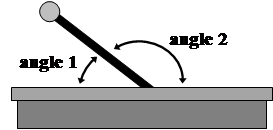Add Angles (Grade 4)
Related Topics:
Lesson Plans and Worksheets for Grade 4
Lesson Plans and Worksheets for all Grades
More Lessons for Grade 4
Common Core For Grade 4
Videos, examples, solutions, and lessons to help Grade 4 students learn to recognize angle measure as additive. When an angle is decomposed into non-overlapping parts, the angle measure of the whole is the sum of the angle measures of the parts. Solve addition and subtraction problems to find unknown angles on a diagram in real world and mathematical problems, e.g., by using an equation with a symbol for the unknown angle measure.
Common Core: 4.MD.7
Suggested Learning Targets
-
I can explain that the angle measurement is the sum of its decomposed angles.
-
I can write an equation with an unknown angle measurement.
-
I can solve word problems involving unknown angles.
Adding Angles – 4.MD.7
In this video, students will learn to add angles. This video relates to Common Core Standard 4.MD.7. Students learn about the additive property of angles. How to compose and decompose angles?
Complementary, Supplementary and Vertical Angles - 4.MD.7
Students learn about supplementary, complementary and vertical angles. Students learn the definitions of these three angles and how to use this knowledge to find a missing angle.
What are Supplementary Angles?
Supplementary angles add up to 180°.
Supplementary Angles add up to 180 Degrees
What are Complementary Angles?
Complementary angles add up to 90°.
Complementary Angles add up to 90 Degrees
Vertical Angles
Vertical angles are opposite from each other. They have no sides in common. They are also congruent, or equal to each other.
Finding Missing Angles in Triangles- 4.MD.7
In this video, students will learn to use addition and subtraction to find missing angles. This video relates to Common Core Standard 4.MD.7. Students learn the total interior angle measurements for triangles and quadrilaterals and then use addition and subtraction to solve for the missing angles.
Angles of Triangles Add Up To 180 Degrees
The following activity is obtained from the Howard County School System.
Activity:
Cameron has an electric train. The train’s switch (shown to the right) has a lever that can be pushed forward to make the train go faster or pulled back to make the train go slower.

Cameron noticed that the base of the switch and the lever form two angles: angle 1and angle 2. The angles changed when he moved the lever. Cameron moved the lever forward and used a chart to record the angles formed by the lever.
angle 1 |
angle 2 |
5º |
175º |
20º |
160º |
30º |
150º |
75º |
105º |
Describe how angle 1 and angle 2 changed as Cameron pushed the level forward.
When Cameron pulled the lever back, he recorded the new angles he noticed. After measuring six pairs of angles, he realized that if he measured angle 1 he could figure out angle 2 without measuring it. How can Cameron use angle 1’s measurement to find the measure of angle 2?
angle 1 |
angle 2 |
178º |
2º |
177º |
3º |
170º |
10º |
169º |
11º |
140º |
40º |
101º |
79º |
Try out our new and fun Fraction Concoction Game.
Add and subtract fractions to make exciting fraction concoctions following a recipe. There are four levels of difficulty: Easy, medium, hard and insane. Practice the basics of fraction addition and subtraction or challenge yourself with the insane level.

We welcome your feedback, comments and questions about this site or page. Please submit your feedback or enquiries via our Feedback page.